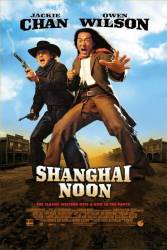Corrected entry: Near the end of the film, in the scene where they return to the Indians' celebration, the Indian woman addresses Roy as Owen, the name of the actor who plays Roy in the film.
Corrected entry: In the Qing Dynasty which reigned China when the story was set, Chinese men, be it commoners or those in the palace, were all bald in the front and wore ponytails at the back. It's the same for Emperor or servants. Although Jackie Chan has a ponytail, why does he have hair in the front?
Correction: During the 268 years of the Qing dynasty, numerous rebellions occurred because of the strict rules regarding dress and hairstyle, this would suggest that not everyone obeyed the rules.
Corrected entry: Roy has a tattoo on his shoulder that is visible in the bath scene. It is a tattoo of a Chinese symbol. Although he is an enlightened man it seems unlikely.
Correction: How is this a mistake? Just because it seems unlikely doesn't mean he wouldn't have it. Maybe he got drunk one night and got it or maybe he lost a bet.
Corrected entry: In the scene near the beginning when Jackie Chan is fighting Native Americans in the river, many of them are chubby. This indicates modern eating habits, rather than the hard-bodied physique that would be the natural result of Native American warriors on a hunter/gatherer diet in 1881.
Correction: Chubbiness is not only from eating, it can be genetic. Also, only the "chubbier" hunter/gatherers would often survive, because they were "built" more efficiantly to survive. And also, they are still very muscular.
Corrected entry: When the drunk is holding the bottle there is no cork in the neck of the bottle. Yet when the horse goes to pick the bottle up to drink from it there is a cork in the bottle.
Correction: The bottle is never seen with a cork.
Corrected entry: When Chon and Roy meet in the bar, the thing holding the cards on Roy's wrist starts to go back under his coat. Then there is a cut to someone else and back to Roy's hand, which still has the card holder sticking out.
Correction: It just stopped going back into his sleeve. You can see it's half-extended and not fully stretched as it was before.
Corrected entry: When Roy and Chon are about to be hung, Roy is shot down from his noose and lands in a coffin. There was only 1 coffin, even though they were both supposed to be hung and buried.
Correction: Although there is only one coffin in the wagon, you can see the other coffin propped up against a buiding in an earlier shot before the wagon starts moving- presumably that is there ready for the second body since there appears to only be room for one coffin at a time inside.






Correction: She does actually say "Roy", but she has a strong Indian accent, and can't speak English perfectly.